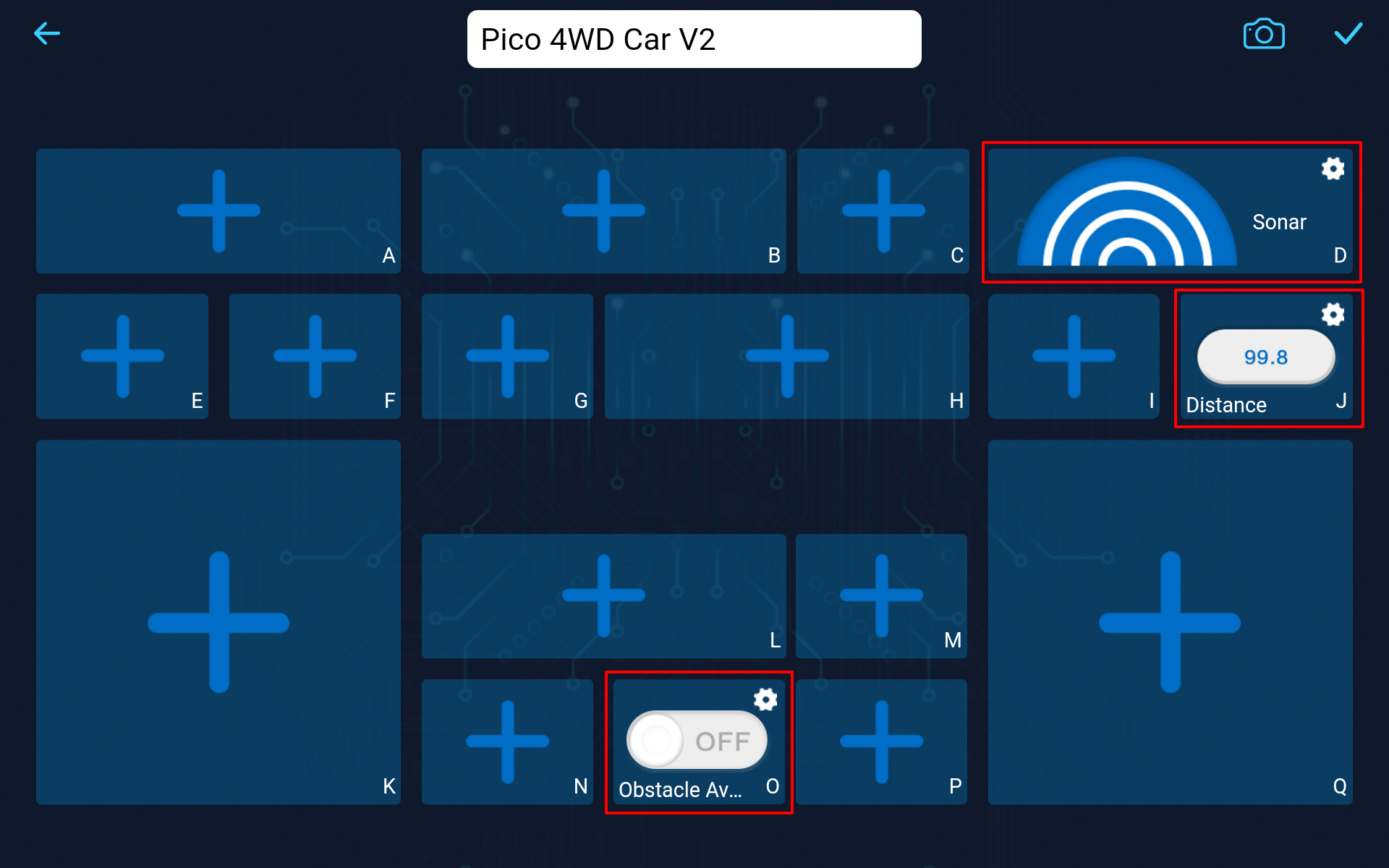9. APP - Avoid¶
Pico 4WD can avoid obstacles automatically!
When an obstacle is detected, instead of simply backing up, the sonar scans the surrounding area and finds the widest way to move forward.
Quick User Guide
Run the
app_8_follow.pyfile under thepico_4wd_car\examples\app_controlpath and then power on the Pico 4WD car.As shown below, create a controller that adds Radar, Number, and Button widgets to the D, J, and O areas, respectively.

After saving (
 ) and connecting (
) and connecting ( ) the controller, click
) the controller, click  to run it.
to run it.As soon as you toggle the Switch widget in the O area to ON, the Pico 4WD car will move forward freely and change direction automatically when it encounters obstacles.
How it works?
In
on_receive(data), the distances and angles are sent to the D and J areas for showing, then responding to the data from the P area.'''----------------- on_receive (ws.loop()) ---------------------''' def on_receive(data): global mode ''' if not connected, skip & stop ''' if not ws.is_connected(): return ''' data to display''' # # sonar and distance ws.send_dict['D'] = [sonar_angle, sonar_distance] ws.send_dict['J'] = sonar_distance # mode select: if 'O' in data.keys() and data['O'] == True: if mode != 'obstacle avoid': mode = 'obstacle avoid' sonar.set_sonar_reference(OBSTACLE_AVOID_REFERENCE) print(f"change mode to: {mode}") else: if mode != None: mode = None print(f"change mode to: {mode}")
Write the
obstacle_avoid()andget_dir()functions to make the car go in a different direction based on the sonar detection.Note
The explanation of the
get_dir()function can be found in 3. Objects Follow.
'''------- get_dir (sonar sacn data to direction) ---------------------'''
def get_dir(sonar_data, split_str="0"):
# get scan status of 0, 1
sonar_data = [str(i) for i in sonar_data]
sonar_data = "".join(sonar_data)
# Split 0, leaves the free path
paths = sonar_data.split(split_str)
# Calculate where is the widest
max_paths = max(paths)
if split_str == "0" and len(max_paths) < 4:
return "left"
elif split_str == "1" and len(max_paths) < 2:
return "stop"
# Calculate the direction of the widest
pos = sonar_data.index(max_paths)
pos += (len(max_paths) - 1) / 2
delta = len(sonar_data) / 3
if pos < delta:
return "left"
elif pos > 2 * delta:
return "right"
else:
return "forward"
'''----------------- obstacle_avoid ---------------------'''
def obstacle_avoid():
global sonar_angle, sonar_distance, avoid_proc, avoid_has_obstacle
# scan
if avoid_proc == 'scan':
if not avoid_has_obstacle:
sonar.set_sonar_scan_config(OBSTACLE_AVOID_SCAN_ANGLE, OBSTACLE_AVOID_SCAN_STEP)
car.move('forward', OBSTACLE_AVOID_FORWARD_POWER)
else:
sonar.set_sonar_scan_config(180, OBSTACLE_AVOID_SCAN_STEP)
car.move('stop')
sonar_angle, sonar_distance, sonar_data = sonar.sonar_scan()
if isinstance(sonar_data, int):
# 0 means distance too close, 1 means distance safety
if sonar_data == 0:
avoid_has_obstacle = True
return
else:
return
else:
avoid_proc = 'getdir'
# getdir
if avoid_proc == 'getdir':
avoid_proc = get_dir(sonar_data)
# move: stop, forward
if avoid_proc == 'stop':
avoid_has_obstacle = True
car.move('stop')
avoid_proc = 'scan'
elif avoid_proc == 'forward':
avoid_has_obstacle = False
car.move('forward', OBSTACLE_AVOID_FORWARD_POWER)
avoid_proc = 'scan'
elif avoid_proc == 'left' or avoid_proc == 'right':
avoid_has_obstacle = True
if avoid_proc == 'left':
car.move('left', OBSTACLE_AVOID_TURNING_POWER)
sonar_angle = 20 # servo turn right 20
else:
car.move('right', OBSTACLE_AVOID_TURNING_POWER)
sonar_angle = -20 # servo turn left 20
sonar.servo.set_angle(sonar_angle)
time.sleep(0.2)
avoid_proc = 'turn'
# turn: left, right
if avoid_proc == 'turn':
sonar_distance = sonar.get_distance_at(sonar_angle)
status = sonar.get_sonar_status(sonar_distance)
if status == 1:
avoid_has_obstacle = False
avoid_proc = 'scan'
car.move("forward", OBSTACLE_AVOID_FORWARD_POWER)
sonar.servo.set_angle(0)
In
remote_handler()function, theobstacle_avoid()function will be called if the obstacle avoid mode is turned on, otherwise the car is stopped.def remote_handler(): ''' enable avoid function ''' if mode == 'obstacle avoid': obstacle_avoid() ''' no operation ''' if mode is None: car.move('stop')